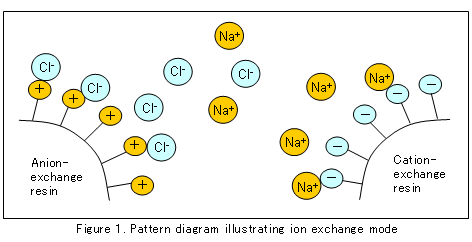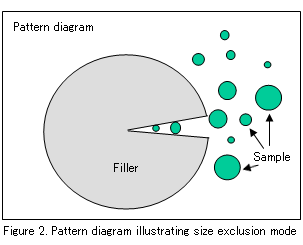5. Separation Mode and Column (2)
Type of separation mode - Separation depends on the triangle relationships among the sample, filler, and eluent! (2)
This chapter is "Ion exchange mode","Size exclusion mode","HILIC mode" following "Adsorption mode","Partition mode".
Ion exchange mode
Ionic substances, including amino acids and inorganic ions pass through an ODS column without being separated by ODS. Such substances can be separated with an ion exchange resin. Negative ions such as chloride (Cl-) and sulfide (SO42-) ions, and positive ions such as Na+ and Ca2+ are separated with anion- and cation-exchange resins, respectively. Despite having both -NH2 (amino, cationic) and -COOH (carboxyl, anionic) groups, amino acids can be separated with cation-exchange resins using an acidic eluent to suppress the dissociation of -COOH. The speed at which a component migrates in the ion exchange column depends on the tendency to become the ion and the tendency to bind to the ion exchange resin for stabilization.

Size exclusion mode
Macromolecular components such as synthetic resins and proteins can be separated according to their size, with sieve-like fillers. The filler is spherical and contains many holes like a mesh. Small molecules can pass through the filler via these holes, but spend much time running through mazes in the fillers. Meanwhile, large molecules unable to enter the holes migrate among the fillers, arriving earlier at the outlet of the column.
Molecules small enough to enter the cavity spend different times passing through the column, according to their sizes.

Once a standard sample with known molecular weight is measured, a calibration curve can be prepared, in which the vertical axis represents logarithmic molecular weight and the horizontal axis represents elution time (volume). Using this curve, the molecular-weight distribution and mean molecular weight of an unknown sample can be determined.
This separation mode is referred to as size exclusion (SEC : Size Exclusion Chromatography) or gel permeation (GPC : Gel Permeation Chromatography).
Unlike separation of low-molecular weight components, SEC/GPC separates molecules according to their size. Thus, it is difficult to separate multiple polymer mixtures having a similar molecular size.
HILIC mode
HILIC is short for Hydrophilic Interaction Chromatography, and is a separation mode based on hydrophilic interaction. ODS mode employs a low-polar filler for separation, based on hydrophobic interaction. HILIC mode employs a silica gel or a highly-polar substance having polar groups as a filler for separation.
If ODS is considered a reverse-phase partition mode, HILIC can be considered a normal-phase partition mode. For ODS mode, water-soluble components are eluted earlier, sometimes leading to insufficient separation. Such separation can be ameliorated in HILIC mode, because water-soluble components are eluted later. To delay elution, a mixture of organic solvent and water is used as eluent at a high ratio of the organic solvent.
For example, sugar analysis with an NH2 column is performed by HILIC mode. This mode is of advantage especially for separation with LC-MS because of its ability to perform separation at a high ratio of organic solvent.
